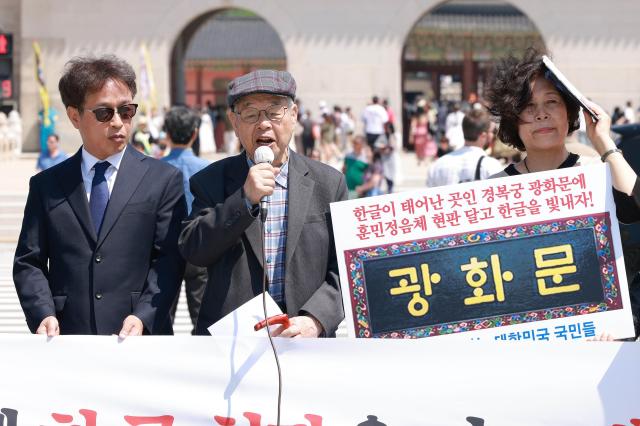
SEOUL, May 29 (AJU PRESS) - A group of scholars and activists demanded Wednesday the government replace the Chinese-lettered signboard of Gwanghwamun, a landmark gate in central Seoul, with one written in the Korean alphabet, Hangeul, citing concerns about national pride and cultural identity.
About 20 advocates of Hangeul held a news conference in front of the main gate of Gyeongbokgung Palace, organized by the Korean Language Society and other Hangeul-related institutions.
"Hangeul stands as a source of pride for Koreans, recognized globally as an innovative and scientific writing system," they said in a statement.
They noted that the Korean writing system was created in the very palace by King Sejong of the Joseon Dynasty in 1443.
“It is natural that the signboard of Gwanghwamun, the main gate of the newly rebuilt palace, should be in Hangeul," the statement reads.
They argued that the current signboard would damage national pride and lead to historical misinterpretation.
"The signboard in Chinese characters may give foreigners the impression that Korea was a vassal state of China," they said.

Their campaign gained fresh momentum recently after Culture Minister Yu In-chon advocated for the change on May 14 during an event commemorating the 627th birth anniversary of King Sejong.
"King Sejong created Hangeul with the spirit of independence, declaring 'our language is different from China's,'" the activists said.
Before the creation of Hangeul, traditional Chinese characters were the only writing system in the nation.
Initially built in 1395, Gyeongbokgung Palace has undergone a checkered history of destruction and reconstruction.
The main royal palace during the Joseon Dynasty was burned during the Japanese invasions of Korea in 1592. It was restored in 1865 but destroyed again during the Korean War from 1950 to 1953.
From 2010 to 2014, a sign with Chinese characters on a white background with black lettering hung above the gate. This sign was repaired in 2011 due to cracks, and then replaced entirely in June 2014. Then the use of Chinese characters sparked controversy, with Korean language groups advocating for a sign in Korean script. However, the decision was made to keep the Chinese character sign.
The current sign, installed in October 2019, features Chinese characters with a black background and gold lettering.
Copyright ⓒ Aju Press All rights reserved.




